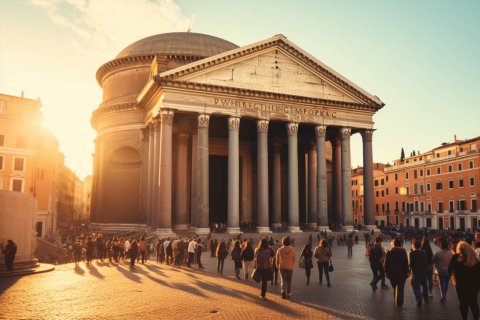History of the Pantheon, Architectural Marvel of Ancient Rome
The Pantheon, an architectural marvel of ancient Rome, stands as a testament to the ingenuity and grandeur of Roman engineering and design. This iconic structure, known for its distinctive dome and impressive interior, has a rich history that spans over two millennia.
The Pantheon's construction can be traced back to the reign of Emperor Augustus, with the original temple on the site being commissioned by Marcus Agrippa around 27 BC. However, the current building we marvel at today owes its existence to Emperor Hadrian, who rebuilt it between 118 and 128 AD. It's fascinating to note that the Pantheon has endured for centuries as one of the best-preserved buildings from ancient Rome.
Architectural Marvel
The most striking feature of the Pantheon is undoubtedly its dome. Made of concrete, the dome's construction was an architectural marvel of its time. It was the largest dome in the world until the Renaissance and remains the largest unreinforced concrete dome to this day. The dome's impressive diameter of 43.3 meters and the oculus, a circular opening at the center, allow natural light to flood the interior.
The use of concrete in the Pantheon's construction was revolutionary. A special lightweight aggregate known as pumice was used to make the dome's concrete, resulting in a structure that was both sturdy and relatively lightweight. The combination of concrete and the dome's design allowed it to support its own weight without the need for internal supports, a remarkable engineering feat for its time.
Religious Significance
The Pantheon was originally dedicated to the Roman gods, with its name derived from the Greek words "pan," meaning "all," and "theos," meaning "god." It served as a place of worship and devotion for the people of ancient Rome. Over the centuries, the Pantheon's religious significance evolved, and it was consecrated as a Christian church in the 7th century AD. It remains a functioning church to this day, known as the Basilica di Santa Maria ad Martyres.
Interior Splendor
Stepping inside the Pantheon is like entering a world frozen in time. The interior features a perfect spherical space, with the oculus in the dome acting as a celestial window. As sunlight streams through the oculus, it creates a breathtaking play of light and shadow throughout the day. The floor is adorned with a beautiful marble design, and the walls are adorned with various niches and altars.
The Pantheon's dome interior is a marvel in itself, with its coffered ceiling adorned with decorative coffers, some of which have been lost to time. The precise symmetry and balance in the design of the interior are awe-inspiring, a testament to the architectural and engineering skills of the Romans.
Frequently Asked Questions (FAQs)
1. Is the Pantheon still in use today?
Yes, the Pantheon is still in use today as a Christian church known as the Basilica di Santa Maria ad Martyres.
2. How was the Pantheon's dome constructed?
The Pantheon's dome was constructed using concrete made with a special lightweight aggregate called pumice. It is the largest unreinforced concrete dome in the world.
3. When was the Pantheon originally built?
The original Pantheon temple on the site was commissioned by Marcus Agrippa around 27 BC. However, the current building was rebuilt by Emperor Hadrian between 118 and 128 AD.
4. What is the significance of the oculus in the Pantheon's dome?
The oculus is a circular opening in the Pantheon's dome that allows natural light to enter the interior, creating a stunning visual effect and symbolizing the connection between the structure and the heavens.



